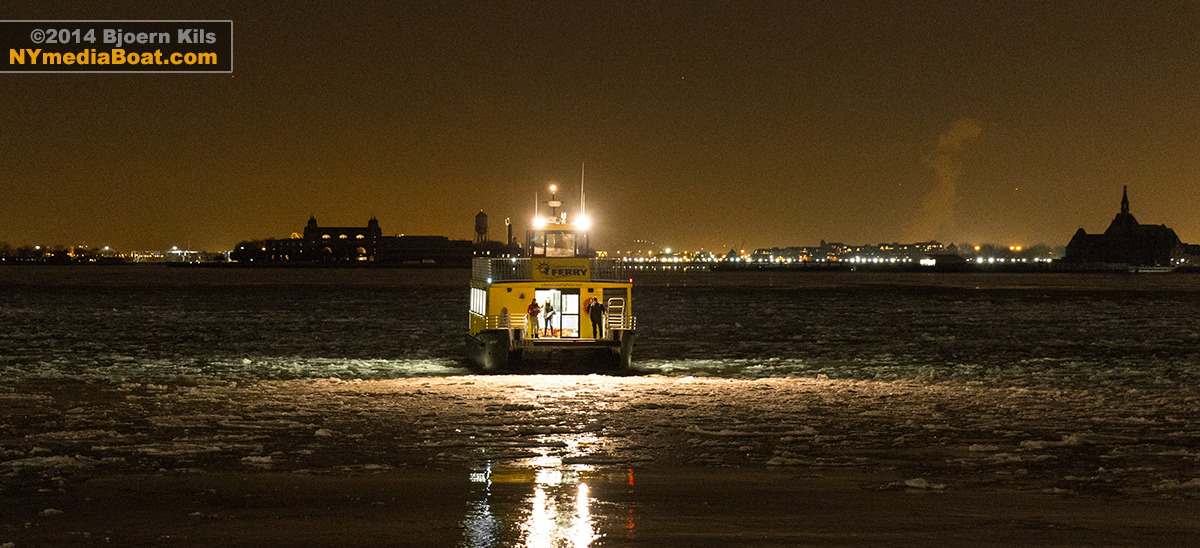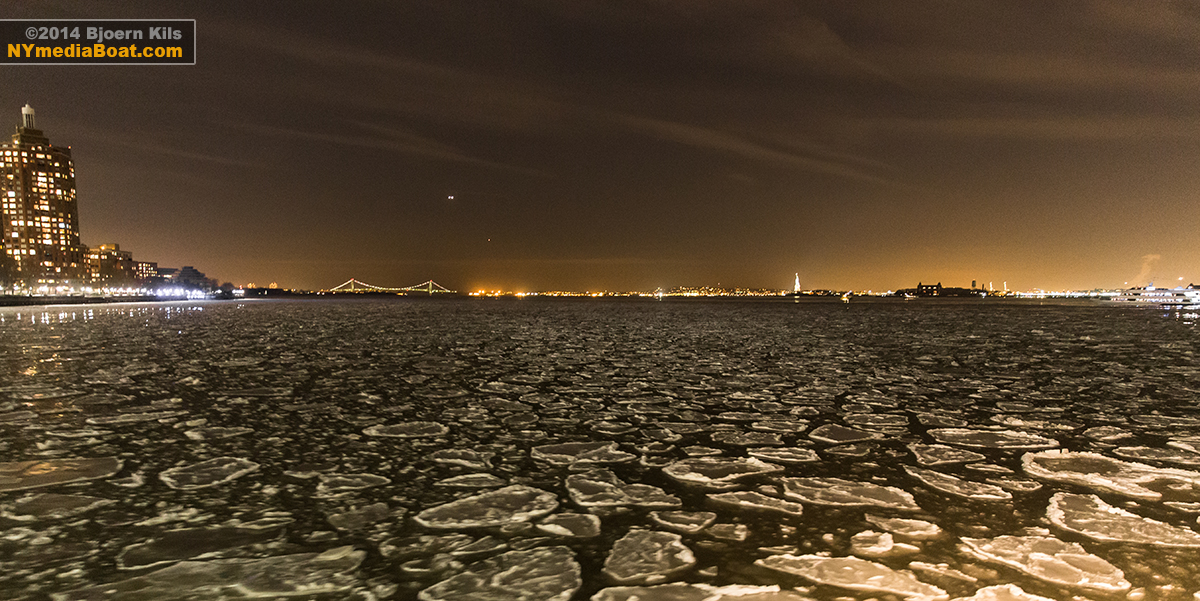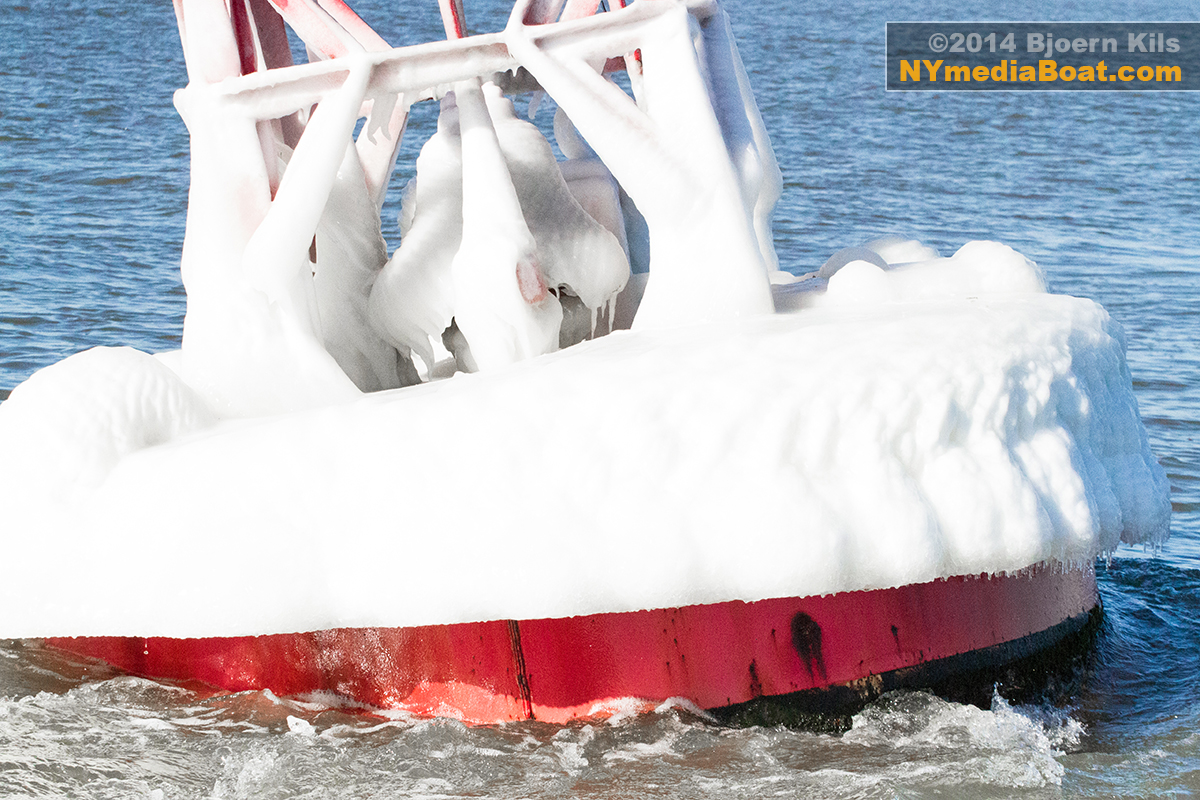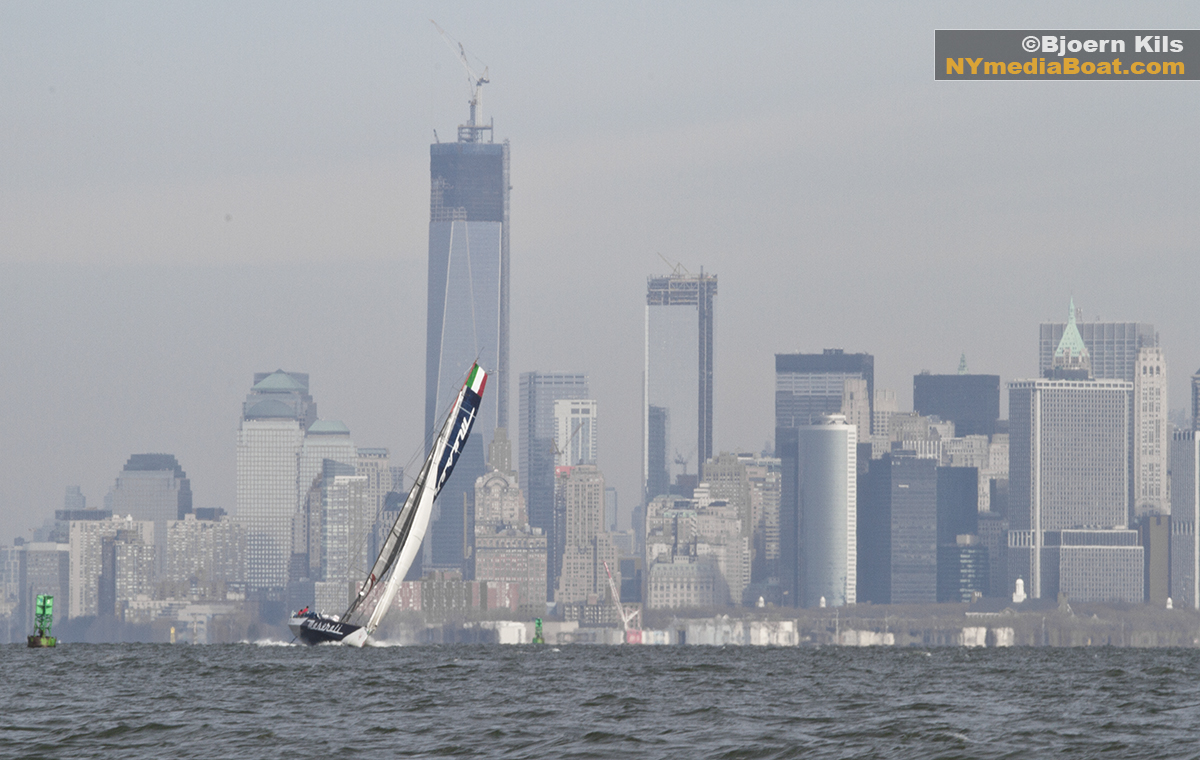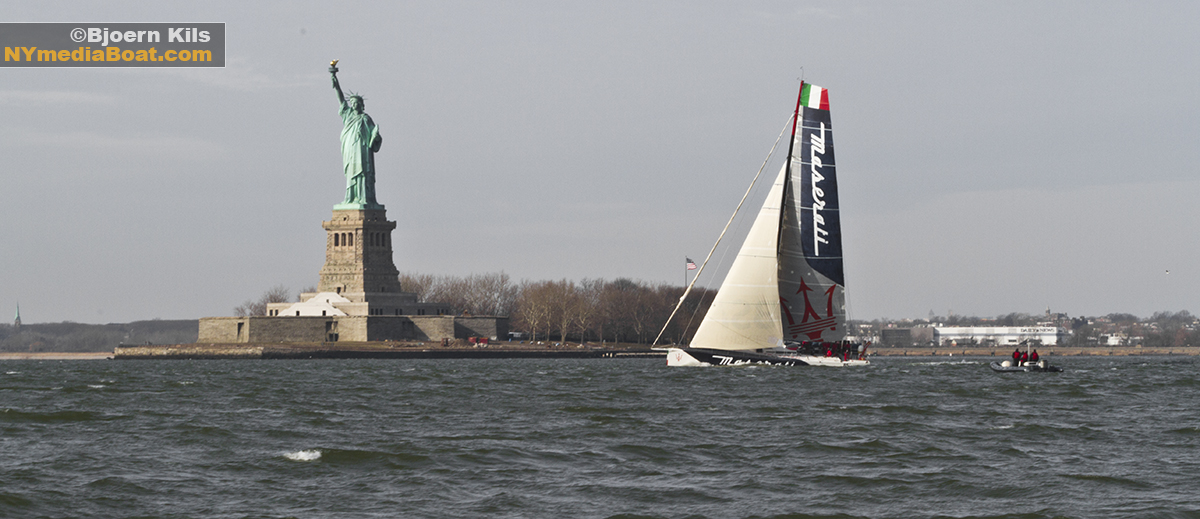After four consecutive days of temperatures topping out in the low 20’s (-6C), ice started forming quickly in many areas of New York Harbor.
The outgoing tides swept ice floes downriver, making navigating the Hudson and East River a bit of a challenge:
In the Washing Machine
It’s the middle of January — the phrases ‘Small Craft Advisory’ and ‘Gale Warning’ are part of today’s NOAA forecast. Looking out past the Statue of Liberty, I see whitecaps blowing off the wave’s crests and New York Harbor appears to boil. I’ve been wanting to put the foul weather gear through its paces so we gear up to face the choppy water. The kits consist of Henri Lloyd TP2 pants, Tretorn Skerry boots, Musto HPX jackets, Mustang PDFs with FastFind PLB & Icom VHF plus Gill offshore gloves and FOX motocross goggles. After turning on the GoPro I set course for The Narrows running at 20 knots and 30 degrees to the wind and waves. Good amounts of water are flying across the deck and the boat’s handling is unaffected by the conditions due to its deep V-hull.
The ‘Heavy Weather Operations Reference Manual’ reads: ‘Wind itself up to 70 mph has little dangerous effect on the RIB (unless airborne)’. After forty-five adventurous minutes, we’re still dry and warm and return to the dock with a new level of respect for choppy harbor waves.
Around the Horn in 40 Days
American sailor Ryan Breymaier raised a thin metal pipe and chipped away at a layer of ice that had formed overnight on parts of Maserati’s deck.
Skipper Giovanni Soldini took a sip of hot tea from a friend on the dock and lit a cigarette to stay warm.
“We are looking forward to go and reach the hot water as soon as possible because it’s cold,” Soldini told me as we shivered in the morning light at North Cove Marina, where the crew was readying Maserati for her departure.
“When we reach the Gulf Stream,” he said, “the air will be warmer and life will be easier.”
The week was the coldest that Soldini and his crew of eight had experienced since they arrived in New York on December 4. They were awaiting the ideal conditions to make a run for the New York to San Francisco monohull world record: 57 days.
The northwest winds on this last day of 2012 were exactly what the modified Volvo Open 70 needed to push her “just south of east,” as navigator Boris Herrmann described the initial heading of 110 degrees. The 14,000-mile route first stretched the team south and eastward into the Atlantic almost the length of the continental U.S., around the elbow of Brazil, down the South American coast and ‘round the treacherous Cape Horn.
Then they’d rush back up north through the Pacific Ocean almost midway between French Polynesia and Chile, across the equator for a second time, and into San Francisco.
Since it’s impossible to predict the weather 40 days out – their target time, as they’d also like to take the overall record of 43 days, held by the catamaran Gitana – the forecast for the first week is critical. Soldini said the day’s increasing northwest winds, ultimately predicted to reach 35 to 40 knots, would help slingshot them well north of Bermuda, and eventually into the trade winds.
“If everything goes to plan, we could be in 10 days at the equator,” Herrmann said on the dock at North Cove at around 8 am on the last day of the year. “We hopefully only suffer two days from this cold.”
After hitting the easternmost point of Brazil, Maserati will stay close to the South American coast all the way to Cape Horn, where she’ll likely pass through the Le Maire Strait into the Drake Passage.
Soldini, Braymeier, and Herrmann have all been ‘round the horn, but never “the wrong way around,” Herrmann said.
“I’ve been around two times,” Soldini told me, “but in the good direction!”
Herrmann said that there’s a 60% chance the winds will be working against them, with the likelihood of favorable winds at “just a few percent.”
And the odds are high that they’ll have a low-pressure system waiting for them there.
“Getting around Cape Horn without having to stop and wait … is key to success with this record,” Breymaier said. “If you can get around quickly and get moving north again, you’re golden. If not you could sit there for a long time.”
Soldini said a storm could stymie them for up to a week. And once they get through, they’re still only halfway there. The next part of the voyage takes them far off the Chilean coast, thousands of miles offshore and possibly half way to the French Polynesian islands.
Then it’s back across the equator and up the North American coast – the “upwind part at the end that could be a little bit boring,” Breymaier says – and finally in to San Francisco.
“It could happen that we have to make a big detour” to get into San Francisco, Herrmann says. “It depends on the weather we find there. That’s too far away now to predict.”
Herrmann has tried to predict it, though. He’s run models for the trip based on 20-year historical weather data and the best routes put them in San Francisco in 42 days.
The average, though, is 55 days, and some – when the weather was never in their favor — put them in San Francisco much later.
The caveat is that the historical models were of “very low resolution,” Herrmann says, relying on weather information from only 12-hour intervals. But they don’t clash too much with the sailors’ intuitions.
“The multihull record is 43 days – that’s 16.5 knots average for the course, which is pretty high,” Breymaier told me after the ice had been hacked away. “We’re dreaming we can make it in 42 and say we have the overall record, but that’s certainly not a safe bet to make.”
“I think we’re gonna be somewhere between 45 and 50.”
The increasing winds – and the chill they brought – upped the crew’s motivation to leave, and by 10 am Maserati had pushed back from the dock at North Cove and sailed out into the Hudson.
Soldini said they haven’t made any definite plans if they do make it all the way around, but if they complete this historical route, there will be a “big party, first thing,” he says. “Then we’ll see.”
Interview mit Boris Herrmann in New York (German)
Kurz bevor Giovanni Soldini und crew in New York ablegten, sprach Navigator Boris Herrmann exklusiv mit ‘New York Media Boat’. Das Team versucht mit der 70 Fuss (21 Meter) langen Volvo Ocean Race Yacht ‘Maserati’ einen neuen Rekord von New York nach San Franzisko zu erstellen. Gestern segelten sie vor Manhattan an der Freiheitsstatue entlang, zur offiziellen Startlinie bei ‘Ambrose Light’ und Herrmann hofft in etwa zwanzig Tagen Kap Horn zu umrunden.
After the Storm
After successfully relaunching ‘Aperture’ at Liberty Harbor, we got right back to business.
CNN put a TV crew on board to get exclusive footage of the devastation Hurricane Sandy caused to Coney Island, the Rockaways and Staten Island. Maneuvering through the floating debris was challenging despite having stationed a spotter at the bow, dodging telephone poles, trees, logs, even partial docks that were making their way down the Hudson. Norton Point was hit hard. The ocean literally came into peoples living rooms and many houses were simply gone. The Rockaways were still smoldering from the extensive fires; Old Orchard Lighthouse knocked down, and many half-sunken boats adrift in the Lower Bay, and washed ashore at Staten Island and Sandy Hook.
Atlantic Highlands Marina didn’t fare well. We observed dive teams from as far away as Texas working around the clock raising sunken vessels with lift bags, and clearing paths for the commuter ferries to resume service. USCG cutters and NAVY ships were stationed just offshore, providing security and other support functions to the hard-hit communities. The port condition was set at YANKEE – restricting all recreational boats and only permitting commercial vessels to transit.
Great Kills Harbor was a sad sight as well. It seemed like a total loss of the marina. While some boats turtled and sunk at their moorings, most were piled on top of each other at the western side of the basin — many impaled by pilings as the water from the 13.8 foot storm surge receded. Other TV crews and still photographers also came aboard that week following Sandy’s landfall and we were able to document the destruction before NYPD stationed a patrol boat at the entrance closing the marina.
We put down hundreds of nautical miles surveying the shorelines, and whenever we came across floating debris dangerous to navigation we reported it’s position to the Coast Guard’s VTS.
This sure was an epic storm.
Camera Zombies in Jersey’s Ninth Ward
This part of Union Beach wasn’t a summer community. You could tell by the Christmas decorations, the middle school calendars, the ice skates, the vinyl records dusted with silt and scattered among wooden beams that had been snapped like matchsticks by the force of the water.
Some of the homes on Brook Ave had been lifted off their foundations and pushed yards away, leaving behind cement staircases leading to nowhere. First floors were swept out from underneath roofs that were now pitched like tents in a refugee camp.
Homeowners still moved about the ruins, though many had already been back to salvage the essentials. They posed religious statues and animal figurines that had no place in temporary shelters as guards along cinder-block foundations, as if they could keep the waters from rising up once more.
Governor Chris Christie made it clear that folks along the barrier islands needed to “get the hell off.” But was there a similar charge for the people who lived along south Raritan Bay? We’d heard stories from other passersby of residents waiting on their roofs for a boat rescue when the waters rose with a speed that no one had anticipated.
Union Beach was New Jersey’s Ninth Ward.
The sooty vinyls caught my attention. Was this a grandfather’s collection? How many generations had lived in these homes? I scanned them for an artist or album title I would recognize – anything that would make this tragedy mine. I was trying to understand why some of these residents were so hostile to visitors, taking the time to post signs like “No Camera Zombies” and “Did You Get Enough Pics?”
We had heard the whispers in Seabright, too. Its 10-foot sea wall couldn’t keep the ocean from meeting the bay, dumping five feet of sand in its streets and pouring five feet of water into some first floors. The sea punched right through beachfront wedding venues and knocked cabanas back against the sea wall, like exhausted boxers clinging to the ropes.
“Sightseers,” I heard someone mutter as we walked down Center Street. If only they’d known that Bjoern lived here 10 years ago. Perhaps they retracted their acrimony once they saw us talking with his former landlord, their neighbor.
I wanted to tell them, I get it. I wouldn’t want my home to be your tourist attraction either. Throughout our survey, I would look away if the seas had ripped out a front door or a bay window, exposing a living room or dining room. I hadn’t been invited into those spaces.
But the Jersey Shore belongs to everyone who lives in the state. We cried for your loss and we bear the burden of rebuilding, too. We are your volunteers, your donors. Don’t shut us out.
Before the Storm
With Hurricane Sandy approaching and the NY Harbor storm surge prediction at 9-12ft above normal plus a full moon, we made the decision to pull ‘Aperture’ out of the water and move her about 20 miles inland. We’ll re-launch as soon as conditions permit to start documenting the damage of this epic storm.



